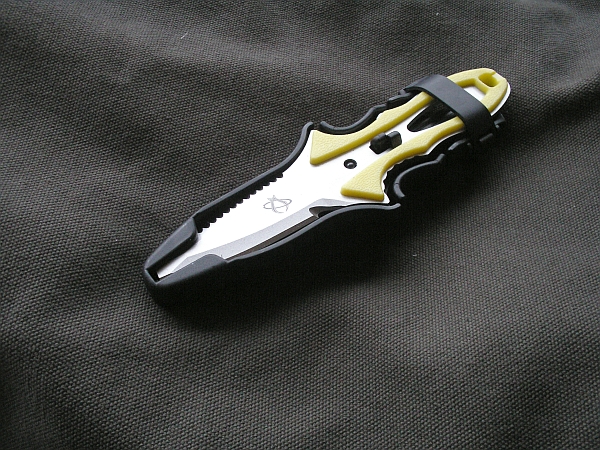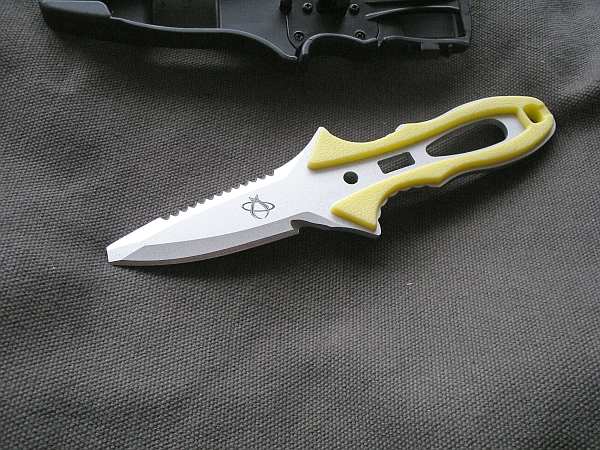Mantis Knives MU1
Review by Phil Elmore
It was in early 2007 when The Martialist first took note of Mantis Knives, a brand that seemed to appear out of nowhere in dealer catalogs and knife magazine advertisements. Contacting a real, live human being through the company's website proved surprisingly easy. We are therefore happy, after a year of living and working with these knives, to present long-term reviews of this company's blades.
 According to Jared West, owner of Mantis Knives, the company was
founded in late 2005 and debuted at the 2006 SHOT Show. "The
Mantis Logo came to me before the name did," Jared told me. "I
was sitting in an International Business class at the Hilton Business
School at L.M.U. in 2001. I was taking notes, and this logo just
hit me, so I scribbled it down. I revised it a couple of
times. Now it's the logo that you see on every Mantis Knives box
that ships out of our Anaheim Hills headquarters."
According to Jared West, owner of Mantis Knives, the company was
founded in late 2005 and debuted at the 2006 SHOT Show. "The
Mantis Logo came to me before the name did," Jared told me. "I
was sitting in an International Business class at the Hilton Business
School at L.M.U. in 2001. I was taking notes, and this logo just
hit me, so I scribbled it down. I revised it a couple of
times. Now it's the logo that you see on every Mantis Knives box
that ships out of our Anaheim Hills headquarters."
That headquarters is a 10,000 square foot facility in Orange County,
California. Some of the knives in the Mantis line are made in the
United States, while others are assembled in Taiwan from US-made
materials (sent by Mantis from Crucible and other sources). The
result is a line of affordable knives of decent quality for the money,
including the only brand of knives officially sanctioned by the United
States Catfish Anglers Tournament Series. "We're the only company
they endorse," Jared states. "We're [also] the only knife
company in the world to offer S30V stainless steel on a folder for less
than $100.00 [USD]."
Jared carries his own company's MK1 model when "hucking boxes and
working in the shop or warehouse." While out on the town, dressed
nicely, or in formal meetings, he carries "my MT2SC. It's slim,
lightweight, and elegant." Price, performance, and style are what
set his company apart from others, according to Jared. "Put our
knives to the test," he urges. "They endure. Every Mantis
knife has a unique, post-modern, industrial look to it. Ever
since I was young, I've been into strange angles and structures in
architecture and design. If I were to design a building, it would
look an awful lot like the Getty Center in Los Angels, or maybe even
the Walt Disny Concert Hall."
At just 27 years old, Jared is a young entrepreneur who seems eager to take on a competitive and often politically charged industry. Mantis' blade materials range from stainless steels like 420HC to more rugged alloys like BG42 and 154CM. Handle materials also range from unusual metal designs to more conventional G10 and carbon fiber slabs.
The Mantis MU1 "Mako" is a stylized dive knife. Many knife companies offer dive knives in their product lines, and Mantis is no exception. I have handled and tested many, though I've never spent five minutes diving in my entire life. As such, I can evaluate the knife only as what it is, though I can see some of the applications of its design features.
The knife itself is just over seven inches overall and has a three inch blade of 420J2 steel (for rust resistance). The handle slabs are dayglo green-yellow plastic for visibility should the knife be dropped underwater (a desirable feature in a dive knife). The handle is skeletonized and features a lanyard hole.
The blade features a pry-bar/screwdriver/probe tip, a section of serrations (ground on one side only) and a primary edge ground on both sides (except for the rope/line-cutting slot). The guard is integral and there is thoughtful grooving on the top and bottom for the thumb and forefinger. The knife feels good in the hand and is comfortably ergonomic, which I would think is very important for a knife used underwater.
The plastic sheath is a complicated affair involving a quick-release mechanism. The user squeezes the sheath at the top and bottom to cause the knife to pop free (when the upper, rubberized retaining strap is released by hand). I had a little trouble getting the knife into my hand when it popped free from the quick release; I eventually discovered that the pinky of the drawing hand must be used to pull the rear of the knife handle free of the plastic sheath enclosure.
My sample shipped with a pair of nylon and plastic straps, including some mounting hardware and tiny screws.
If you are a diver looking for a stylish, full-featured underwater blade, this one is worth consideration. >>

